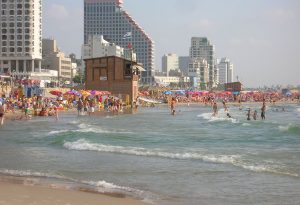
In May of this year, foreign tourists entering Israel hit an all-time monthly high, and 2017 is projected to be a record-breaking year for vacationing tourists.
By Ilan Gattegno
Three years after incoming tourist numbers slumped following Operation Protective Edge in July-August 2014, tourism to Israel has fully recovered and will hit an all-time high this year, according to the Tourism Ministry. The rise was attributed to the introduction of the open skies policy and massive marketing efforts by the ministry.

Tel Aviv – Photo: Boris Kuznets
Israel previously reached its highest tourism figures before the 2014 military campaign against Hamas in Gaza, but when that began and rocket fire pummeled southern Israel and reached as far as the Sharon region northeast of Tel Aviv, incoming tourism dropped sharply. Given that it came at high season, the blow to the tourism industry that year was particularly harsh.
But even while Operation Protective Edge was still underway and tourists were staying away, the Tourism Ministry decided to continue its previously planned marketing efforts.
RELATED:
- 欢迎! Israel Welcomes Chinese Tourism Boom, With Enthusiasm!
- Israel launches tourism ad campaign for India TV
- Portugal’s Tourism Minister In Israel to Emulate Smart City’s Technology
For this purpose, an interministerial team headed by Tourism Ministry Director General Amir Halevi was set up and charged with finding tools with which to deal with the tourism crisis, as well as better prepare the industry for any future crisis. The team consulted with employees and business owners in the tourism industry and government officials, and also evaluated the state of global tourism.
The team made a series of decisions that included government compensation for hotels based on the drop in incoming tourism they experienced, and incentives to spur tourism to the south of Israel. One major step was to fund professional seminars for those who work in the tourism industry to prevent trained, experienced personnel from leaving the sector.
With the wave of terrorism that broke out in October 2015 keeping tourists away, it was only two years after Operation Protective Edge that incoming tourism made a full recovery.
In November 2016, incoming tourism returned to pre-Protective Edge numbers. In May this year, tourist entries hit an all-time monthly high, and 2017 is projected to be a record-breaking year for incoming tourism.
“During Operation Protective Edge, there was of course a drop in tourist traffic and tourist revenue, but to our joy, recovery was relatively quick. This was the result of the amazing enlistment of the Israeli people, who helped us out and flocked to our tourist sites, demonstrating touching solidarity,” said Livnat Ginsburg, tourism coordinator for the Sadot Shikma-Basor Tourism Association, which encourages travel to southern Israel.
“However, we can’t ignore the fact that Operation Protective Edge had a widespread effect on the Israeli tourism industry as a whole, not just the south’s tourism. Even today, any escalation or terrorist incident causes cancellations, which have a short-term impact,” Ginsburg said.

Hiking around the Sea of Galilee – Photo: Boris Kuznets
A 2015 study from the World Travel and Tourism Council shows that it takes longer for a country’s tourism industry to recover after a war or political unrest than from a terrorist attack, epidemic, or natural disaster.
On average, tourism figures return to pre-war levels 27 months after the end of a conflict, but not every country sees the same rates of recovery. The Madrid bombing in 2002 had a much smaller effect on tourism to Spain than the similar bombing in Bali in 2005 had on tourism in Indonesia.
According to some estimates, the recent terrorist attacks in London could cause as much as a 30% drop in the city’s incoming tourism.
View original Israel Hayom publication at:
http://www.israelhayom.com/site/newsletter_article.php?id=43611






 Israeli New Shekel Exchange Rate
Israeli New Shekel Exchange Rate